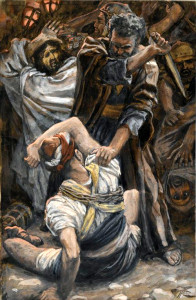This is the eighth installment in our series on undesigned coincidences in the gospels, based on a presentation by Dr. Tim McGrew. For an introduction to undesigned coincidences and this series, go here.
Peter Fights to Defend Jesus
In this short post, we’ll look at an undesigned coincidence between the gospels of John and Luke. The gospel of John tells us that when the temple guards came to arrest Jesus, his disciple Peter drew a sword and attacked one of the high priest’s servants, cutting off his ear. Here’s the account in John 8:10-12 (NIV):
10 Then Simon Peter, who had a sword, drew it and struck the high priest’s servant, cutting off his right ear (the servant’s name was Malchus).
11 Jesus commanded Peter, “Put your sword away! Shall I not drink the cup the Father has given me?”
12 Then the detachment of soldiers with its commander and the Jewish officials arrested Jesus. They bound him 13 and brought him first to Annas, who was the father-in-law of Caiaphas, the high priest that year.
Later, the Jewish authorities hauled Jesus before the Roman governor, Pontius Pilate. According to John, Pilate asked Jesus if he was a king. John 18:36 records Jesus’ response:
36 Jesus said, “My kingdom is not of this world. If it were, my servants would fight to prevent my arrest by the Jewish leaders. But now my kingdom is from another place.”
Jesus’ answer seems to be inconsistent with the facts, as reported earlier in John. Obviously, John wrote that one of Jesus’ servants, Peter, drew a sword and attacked Malchus. Yet, Jesus clearly indicates to Pilate that his servants did not fight to prevent his arrest. What’s going on here?
Well, if John was our only gospel, we’d never know. Interestingly, Luke’s gospel provides an additional detail that unintentionally clears up the question. Consider Luke 22:49-51:
49 When Jesus’ followers saw what was going to happen, they said, “Lord, should we strike with our swords?” 50 And one of them struck the servant of the high priest, cutting off his right ear.
51 But Jesus answered, “No more of this!” And he touched the man’s ear and healed him.
Luke makes it clear that one of Jesus’ disciples did fight (Peter is not named), but that Jesus rebuked him and immediately healed the injured servant. Jesus effectively “undid” the attack. As Tim McGrew states, “Peter could not be arrested for the assault, nor Jesus contradicted in his claim, because there was no remaining physical evidence of the struggle.”1
The unintentionally interlocking nature of the gospels is what one would expect from independent factual accounts. Such “undesigned coincidences” strengthen the case for the gospels’ historical accuracy.
Notes
- McGrew, Timothy (Ph.D., Professor and Philosophy Department Chair, Western Michigan University), Internal Evidence for the Truth of the Gospels and Acts, presentation to St. Michael Lutheran Church, delivered 27 February 2012, slide 48

